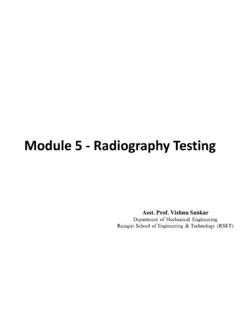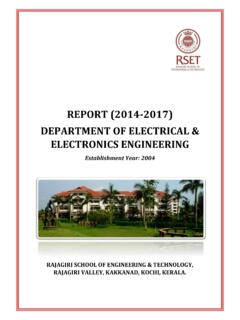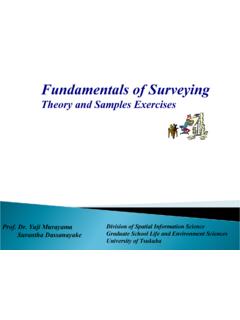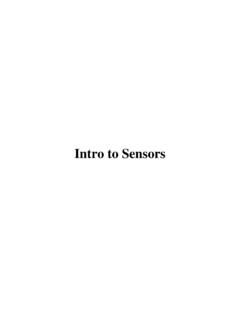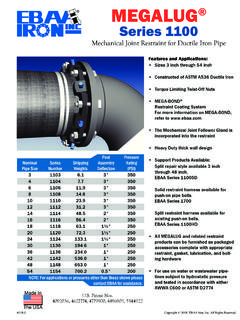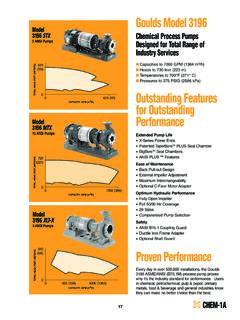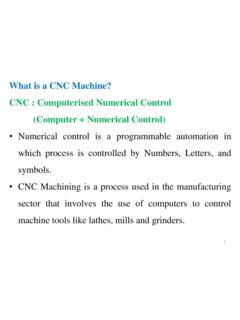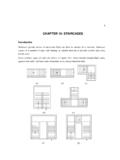Transcription of DESIGN OF MACHINE ELEMENTS - Rajagiri School of ...
1 NivishGeorgeDESIGN OF MACHINE ELEMENTSS haftsDepartment of Mechanical Engineering2 Transmission shaft usually refers to a rotating MACHINE element, circular in cross-section, which supports transmission ELEMENTS like gears, pulleys and sprockets and transmits powerCategories of transmission shafts Axle Spindle Countershaft Jackshaft Line shaftDesign of shafts on strength basisDepartment of Mechanical Engineering3 Shaft subjected to pure axial tensile load 0=32 11 413 Shaft subjected to pure torsional load(Eqn. ) with K=0 for solid shafts 0=16 11 413(Eqn. ) with K=0 for solid shaftsCombined torsion and bending (maximum normal stress theory) =16 + 2+ 2 11 413(Eqn. )Combined torsion and bending (maximum shear stress theory) =16 2+ 2 11 413(Eqn. ) DESIGN of shafts on Rigidity basisDepartment of Mechanical Engineering4 Rigidity Torsional rigidity Lateral rigidity =584 14(Eqn.)
2 Torsional rigidity: Ability to resist twist under the action of an external torqueLateral rigidity: Ability to resist deflection under the action of external forces =584 ( 04 4) (Eqn. ) = DESIGN of shafts on strength basis (Fluctuating load)Department of Mechanical Engineering5 Shaft subjected to pure axial tensile load 0=32 13 Shaft subjected to pure torsional load 0=16 13 Combined torsion and bending (maximum normal stress theory) 0=16 + 2+ 2 11 413(Eqn. )Combined torsion and bending (maximum shear stress theory) 0=16 2+ 2 11 413(Eqn. )Problem of Mechanical Engineering6 The layout of a transmission shaft carrying two pulleys B and C are supported on bearings A and D is shown in Figure. Power is supplied to the shaft by means of a vertical belt on the pulley B, which is then transmitted to the pulley C carrying a horizontal belt.
3 The maximum tension in the belt on the pulley B is angle of wrap for both pulleys is 1800and the coefficient of friction is The shaft is made of plain carbon steel 30C8 (Syt=400 N/mm2) and the factor of safety is 3. Determine the shaft diameter on strength basis. Problem of Mechanical Engineering7 Problem of Mechanical Engineering8 The layout of a shaft carrying two pulleys 1 and 2, and supported on two bearings A and B is shown in Figure. The shaft transmit power at 360 rpm from the pulley 1 to the pulley 2. The diameters of pulleys 1 and 2 are 250 mm and 500 mm, respectively. The masses of the pulleys 1 and 2 are 10 kg and 30 kg, respectively. The belt tensions act vertically downward and the ratio of belt tensions on the tight side to slack side for each pulley is :1. The shaft is made of plain carbon steel 40C8 (Syt= 380N/mm2) and the factor of safety is 3.
4 Estimate suitable diameter of shaft. If the permissible angle of twist is metre length , calculate the shaft diameter on the basis of torsional rigidity. Assume G=79300 N/mm2. Problem of Mechanical Engineering9 Problem of Mechanical Engineering10A layout of an intermediate shaft of a gear box supporting two spur gears B and C is shown in Figure. The shaft is mounted on two bearings A and D. The pitch circle diameters of gears B and C are 900 and 600 mm, respectively. The material of the shaft is steel FeE580 (Sut= 770 and Syt= 580 N/mm2). The factors Cmand Ctare and , respectively. Determine the shaft diameter using the code. Assume that the gears are connected to the shaft by means of keys. Problem of Mechanical Engineering11 Problem of Mechanical Engineering12A hollow transmission shaft, having inside diameter of times the outside diameter is made of plain carbon steel 40C8 (Syt=380N/mm2) and the factor of safety is 3.
5 A belt pulley 1000mm in diameter, is mounted on the shaft which overhangs the left hand bearing by 250 mm. The belts are vertical and transmit power to the MACHINE shaft below the pulley. The tension on the tight side and slack sides of the belt are 3kN and 500 N. The angle of wrap of the belt on the pulley is 1800. Calculate the outside and inside diameters of the shaft. Problem of Mechanical Engineering13 Problem of Mechanical Engineering14A solid shaft of diameter d is used in power transmission. Due to modification of the existing system, it is required to replace the solid shaft by a hollow shaft of the same material and equally strong in torsion. Further, the weight of the hollow shaft per metre length should be half of the solid shaft. Determine the outer diameter of the hollow shaft in terms of dCouplingsDepartment of Mechanical Engineering15A coupling can be defined as a mechanical device that permanently joints two rotating shafts to each otherTypes Oldham coupling Hooke s coupling Rigid or flexible couplingRigid CouplingDepartment of Mechanical Engineering16 : 1: =2 ( ) 2: =3 ( ) 3: =4 ( ) : = +9 ( ) 3: = +5 (.)
6 251) : . =140 +2 380 +2 +3( )) : = ( ) DESIGN Procedure: Rigid Flange CouplingDepartment of Mechanical Engineering17 Obtain the shaft diameter. Standard shaft sizes can be selected from Table , Page 57 Find the dimensions of flanges by empirical relations on Pg251 and Pg252 The inner and outer diameters of the hub are D and D1. = = 14 432 = 12 Shear force on flange = 1 Resistive torque = Shear force 12 =12 12 (Eqn. ) DESIGN Procedure: Rigid Flange CouplingDepartment of Mechanical Engineering18 Decide the number of bolts based on empirical relationship Determine the diameter of the bolts from Eqn. = 2 28 Compressive stress in the bolt from = 22 Dimensions of keys (Page 61) width of the square key , =14 Page 61 Eq. width of the rectangular key, =14 Page 61 Eq. height of the rectangular key, h =16 Page 61 Eq.
7 Table , data book page 69 Check for shear and compressive stresses =2 , =4 : . =140 +2 380 +2 +3( )) DESIGN Procedure: Rigid Flange CouplingDepartment of Mechanical Engineering19 Forces acting on keyProblem Department of Mechanical Engineering20A rigid coupling is used to transmit 20 kW power at 720 rpm. There are four bolts and the pitch circle diameter of the bolts is 125 mm. The bolts are made of steel 45C8 (Syt= 380 N/mm2) and the factor of safety is 3. Determine the diameter of the that the bolts are finger tight in reamed and ground Department of Mechanical Engineering21It is required to DESIGN a rigid type of flange coupling to connect two shafts. The input shaft transmits kW power at 180 rpm to the output shaft through the coupling. The service factor for the application is , the DESIGN torque is times of the rated torque.
8 Select suitable materials for various parts of the coupling and DESIGN the coupling and specify the dimensions of its componentsFlexible CouplingDepartment of Mechanical Engineering22 Can tolerate mm of lateral or axial misalignment and of angular misalignment Absorbs vibrations Used for transmitting high torquesFlexible Coupling: AnimationDepartment of Mechanical Engineering23 Problem of Mechanical Engineering24It is required to DESIGN a bushed pin type flexible coupling to connect the output shaft of an electric motor to the shaft of a centrifugal pump. The motor delivers 20 kW power at 720 rpm. The starting torque of the motor can be assumed to be 150% of the rated torque. DESIGN the coupling and specify the dimensions of its components. Problem of Mechanical Engineering25

